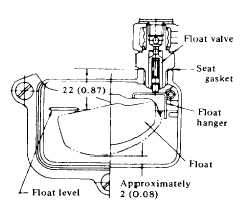| |
TM 10-3930-653-14&P
(2) ADJUSTMENT OF FLOAT LEVEL
Adjust the position of float (up position). Place the
body horizontally with float chamber facing upwards and
keep the body inclined 10 to 15° downwards at upper
side of float chamber. The float then should be
horizontal.
Adjustment is made by increasing or decreasing the
metal plate gaskets at the float valve seat.
Adjust the position of float (down position).
Keep float chamber in its original posture and lower the
float naturally.
Adjustment is made by bending float stopper.
Refer to Fig. 5-4.
Fig. 4-119. Adjusting Float Level.
(3) IDLE ADJUSTMENT
(1) Check to be sure that the float level is correct while
engine is at idle speed.
(2) Using a suitable screwdriver, turn out idle adjusting
screw approximately two or three turns, starting from
fully closed position. Turn in throttle adjusting screw two
or three turns and start engine.
(3) Turn out throttle adjusting screw gently until specified
engine idle speed is approximately obtained.
Turn idle adjusting screw in or out until engine runs
smoothly at highest speed.
(5) Turn out throttle adjusting screw until specified
engine speed is obtained.
(6) Readjust idle adjusting screw until engine runs
smoothly at the highest speed (with the highest vacuum
reading).
(7) Then, throttle adjusting screw must be adjusted so
that engine speed is 20 rpm faster than specified.
(8) Finally, turn in idle adjusting screw until specified
engine speed is attained.
WARNING
Carbon monoxide gas is a colorless,
odorless,
poisonous,
deadly
gas
produced by incomplete combustion
of any carbon containing material.
It occurs in the exhaust fumes of fuel
burning internal combustion engines,
and
becomes
dangerously
concentrated under conditions of
inadequate ventilation.
Note:
a. Items (7) and (.8): Best method to reduce carbon
monoxide in exhaust emission.
b. Do not attempt to screw down idle adjusting
screw completely. If screw tip is damaged, it will
cause engine malfunctions.
Engine idle speed rpm
550
Engine manifold
vacuum at idle
speed
mmHg (inHg)
-430
(-16.9)
(4) JET
The larger numbers punched on jets to measure
gasoline indicate richer fuel-air mixture, and the smaller
numbers indicate leaner mixture. Main and slow air
bleeds are provided with passages to let air in to make
lean fuel-air mixture.
The larger numbers indicate leaner mixture, and the
smaller numbers indicate richer mixture.
This should be noted when the conditions require a
change of mixture, such as high altitude.
4-70
|

